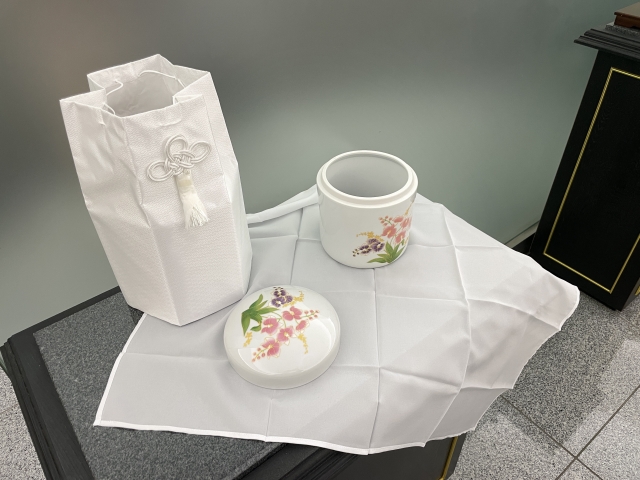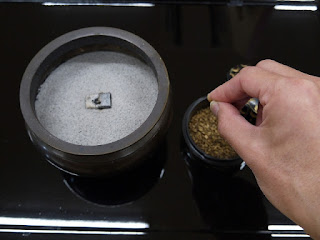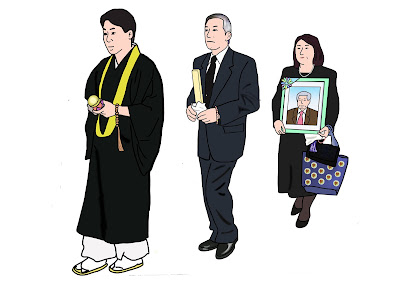My mother passed away from lung cancer in March. I have calmed down at the moment. I was by her bedside when she departed this life at the hospital. A funeral director took her from the hospital to my home, though bodies are often taken directly to the funeral home.
My family's religion is Shingon Buddhism, a school of Japanese Buddhism. She was laid with dry ice on her futon with her head pointed northward. A white cloth covered her face. An incense stick was lighted on a low table by the futon.
The next day, my family members made funeral arrangement with the funeral director. We chose a traditional Buddhist-style altar, a cinerary urn with cherry blossoms pattern, a paisley-upholstered coffin, a shroud(dianthus-patterned kimono made of smooth satin), her photo and a green frame for it, funeral flower stands, and a hearse. Kimono for the dead is sewn by slightly different way.
 |
| flower-patterned cinerary urn and its fabric cover |
Ordinarily Buddhists hold a wake called tsuya(通夜) and funeral service. Tsuya is held around 7 p.m. The next day funeral service generally starts at 10 or 11 a.m. Working persons can attend tsuya after work. Most mourners choose either tsuya or funeral service.
In Japan, tsuya is generally held irrespective of creed. Most funeral halls and crematories are closed on the day of tomobiki, which literally means "pulling friends" and is a good day for business and lawsuits. However the word is associated with taking the deceased's friends with the deceased.
I reserved my family temple's priest to read a sutra at a local funeral home and requested him to give my mother a posthumous Buddhist name called kaimyo(戒名.)
Two days after her death, she was moved from my home to the funeral home. Two encoffiners performed a ritual called yukan(湯灌) to encoffin bodies at the funeral home. In front of our eyes, they carefully spilled warm water on her arms and legs, and shampooed her hair. I was so glad to see her hair shampooed because she had taken bed bath after hospitalization. They washed her whole body after we exited the room. Her body in dianthus-patterned white kimono was laid in a upholstered coffin. It is not uncommon for people to sit with and talk to the body almost as if it were still alive. I often talked to her.
 |
| Yukan |
On the day before the funeral service, I took Makurameshi(枕飯, cooked rice offered to the deceased) and Makuradango(枕団子, rice dumpling offered to the deceased) to the funeral home, and put them on the altar.
 |
| Makuradango and Makurameshi |
Makurameshi is a heaped bowl of cooked rice with upright chopsticks in it. It means a final meal of the dead in this world. The bowl and the chopsticks belong to my mother. Each of us has our own bowl for rice and chopsticks. Makuradango comes from the Buddhist episode that a bodhisattva offered rice dumpling to Buddha after his death. They are offered so that the dead can eat them or give them to the hungry departed on the way to the next world. Makurameshi and Makuradango are put in a coffin at the end.
Customs vary by Buddhist sect and region. So we imitate the people ahead of us at the funeral home.
In Japan we offer condolence money for a funeral(香典, koden) to the family of the deceased when visiting them for a wake or a funeral. Koden is sealed in special envelopes tied up with black and white string.
 |
| envelope with white and yellow string (It is used mainly in Kansai region after the 49th day after one's death ) |
There are some envelopes for koden.
 |
| envelope for koden and fudepen((writing brush pen) |
ohanaryo(御花料) (money for offering flowers)
o(n)tamagushiryo(御玉串料) (fees for offering a branch of the sacred tree to a god) goshinzen(御神前)(money for offering to gods)
gobutsuzen(御仏前) (money for offering to the deceased)
 |
| envelopes for koden and juzu(Buddhist rosary) |
 |
| koden-envelope on fukusa |
 |
| koden-envelope in fukusa |
 |
| an example of Buddhist-style altars |
At a wake, a Buddhist priest reads a sutra, mourners pick up crumbled incense (makko) and sprinkle it on a small fraction of charcoal on ashes in the incense burner(koro) to burn.
 |
| A Buddhist priest reads a sutra |
 |
| A mourner picks up crumbled incense |
 |
| burner(left) and incense(right) |
 |
| A mourner sprinkles it on a small fraction of charcoal on ashes in the incense burner |
 |
| A mourner join his hands in prayer after offering incense |
 |
| Mourners offer incense |
The chief mourner(the deceased's family member) expresses their appreciation for coming to the funeral.
After the wake, a light meal such as sushi accompanied with beer and sake is served to mourners. They share some memories of the deceased. The closest relatives may stay and keep vigil with the deceased overnight.
The chief mourner gives attendants a greeting card to express thanks for attending the funeral, salt and an article such as green tea, Nori(dried edible seaweed), handkerchief or hand towel. Mourners sprinkle salt on themselves for purification in front of their doors. Recently salt tends not to be given.
 |
| salt for for purification(left) and a greeting card called kaiso-orei(right) |
Most bereaved families recently conduct small-scale funeral service. The COVID-19 pandemic has encouraged this trend. My relatives are elderly or live far away. Only my family members attended my mum's funeral. We didn't hold a wake.
My mother's funeral service started at 8:30 a.m. on the 6th day after her death. I live in Yokohama city that has 928,450 people over 65 as of March 31, 2021. More people die in the winter than the summer every year. The city has only four public crematoriums. Furthermore, only Covid-19 victims were cremated after 3 p.m. So these crematoriums were booked solid for days.
We made a monetary offering called Fuse(布施) to the Buddhist priest in return for receiving kaimyo and reading sutra before the funeral. We also paid him for transport(御車代, okurumadai).
 |
| Fuse and okurumadai |
The natural spirit tablet(位牌, ihai) with my mother's kaimyo was placed on the altar.
 |
| natural and blank spirit tablet |
At the funeral, the priest read a sutra, we sprinkled crumbled incense in the incense burner and put flowers inside the coffin. I put old letters and a deck of paper cards inside the coffin beforehand. She loved to play contract bridge.
Then we went to a crematorium with her photo in frame, the tablet.
Nowadays most bereaved families choose foreign-type(station wagon or executive sedan) hearse. We also chose a foreign-type hearse.
 |
| Japanese-style hearse |
 |
| foreign-type hearse |
In Japan, more than 99% of the dead are cremated. When the bereaved choose burial, they will go to a great deal of trouble to get a grave for burial. There is little space for burial in Japan.
Only our family members and the priest went to the crematorium. The tablet was placed in front of her body. He read a sutra before cremation. Our family members waited about 1 hour during cremation. Usually deceased person's relatives and familiar persons also go to a crematorium. The bereaved serve a meal to them after (or during) cremation.
 |
| Buddhist priest reads a sutra before cremation |
 | |
|
As a ritual called Kotsuage(骨上げ), paired relatives pick a piece of bone from the ashes with chopsticks and place them in an urn. We transferred some pieces of her bones into her urn. A crematorium technician put other pieces of them into it.
 |
| Kotsuage |
 |
| Paired relatives pick a piece of bone from the ashes with chopsticks and place them in an urn |
After going home, we placed the photo, the tablet, the urn, an incense holder, a candle holder, a singing bowl with striker, flowers, offerings on a post-funeral altar.
 |
| an example of post-funeral altar |
We burn an incense stick, ring the bowl and join our hands in prayer daily until the 49th day after her passing. We still do them every morning.
Kotsuage in old times
 |
| Credit: Japanese funeral customs: after the cremation: three women and a child pick bones from the ashes with chopsticks and place them in an urn. Watercolour, ca. 1880 (?). Wellcome Collection. Public Domain Mark Description Left, a Buddhist monk walks off; right, two men converse, watched by a child |








No comments:
Post a Comment